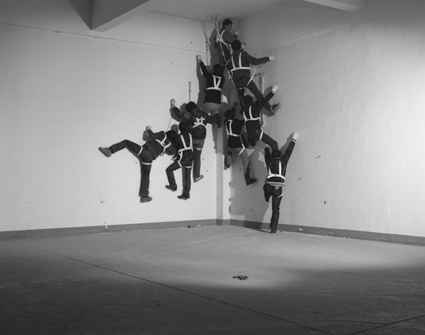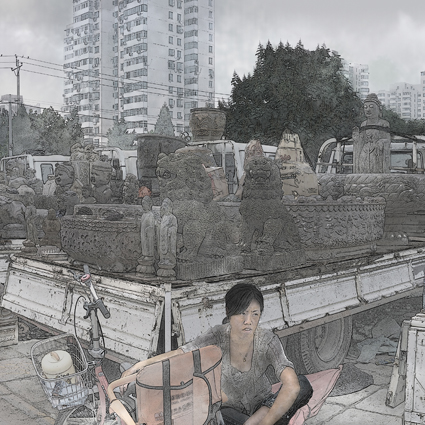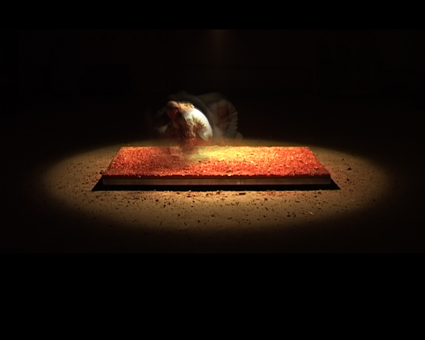individual aspirations, collective expectations
gail priest: arena—a post boom beijing, hazelhurst gallery

still from Total Eclipse (2010), Gao Shiqqiang
courtesy the artist and Magee Gallery, Beijing
still from Total Eclipse (2010), Gao Shiqqiang
IN THE LEAD UP TO THE 2008 BEIJING OLYMPICS AS CHINA’S CAPITAL RAPIDLY REDEVELOPED TO GREET WESTERN CAPITALISM, SO DID ITS ART SCENE. CHINESE CONTEMPORARY ART BECAME THE ‘NEXT BIG THING’ AS GALLERIES AND ART ZONES OPENED UP ALL AROUND THE CITY, WITH INTENSE INTEREST FROM INTERNATIONAL DEALERS AND COLLECTORS. IT ALSO SAW THE ADOPTION OF VIDEO AS A MEDIUM BY MANY MORE CHINESE ARTISTS. LAURENS TAN, AN AUSTRALIAN ARTIST OF CHINESE ORIGIN RELOCATED TO BEIJING IN 2006 AND THE VIDEO EXHIBITION, ARENA, WHICH HE HAS CURATED FOR THE HAZELHURST GALLERY, REFLECTS ON WHAT HAS HAPPENED IN BEIJING AFTER THE INITIAL FRENZY.
Not surprisingly, many of the works exhibited deal with the changing cityscape and the built environment. The most engaging of these is Nan Hao’s Chi 3 (2008) in which Hao performs Tai Chi in the middle of eight lanes of traffic. While it could be seen simply as an act of bravado, Hao’s performance is humble and contained, shifting through small gestural sequences occasionally obscured by large trucks. At one point he holds his hands forward in a stance of resistance, and for a fleeting moment we think that he has succeeded in stopping the oncoming cars, but it’s the traffic lights that have this ultimate power. The footage is low quality, but it adds a sense of intervention and immediacy to this simple yet powerful work.
Beijing Ballet (2010) by Allan Chawner explores similar territory. An Australian artist, in-residence at the Red Gate Studios in Beijing, Chawner has captured a street scene in moody dusk light. Watching the ebb and flow of traffic, he focuses on a man on a bicycle carrying an unbelievably large load. Stranded in the sea of cars he exhibits patience similar to Hao’s, however Chawner aestheticises the experience by replacing the traffic sounds with a version of Debussy’s Clair de Lune. The music heightens and poeticises the visual material but, verging on cliché, steers the piece towards a romanticised western vision of the contemporary east, in effect flattening the power of the original footage and, played at volume, it dominates the gallery space.

Beijing Handscroll (detail, 2009), Miao Xiaochun
courtesy the artist
Beijing Handscroll (detail, 2009), Miao Xiaochun
Also using Beijing streetscape as his material is Miao Xiaochun in the photomedia work Beijing Hand Scroll (2009). Drawing on the ancient art of hand scrolls, which by tradition depict cityscapes in intense detail and can reach to over five meters in length, Xiaochun has used a 360-degree camera to capture panoramas of Beijing streets. Exhibited as stills over eight screens, these panoramas illustrate city crowds, street markets, decrepit lanes and new high-rise developments. The images are manipulated using something like the ‘find edges filter’ in Photoshop creating a density of detail that resembles etching. The images of humans are treated with a variety of smudging tools, giving both a sense of movement and a dreamy insubstantiality to the figures, in contrast to the precise representation of their environments. As you can never take in the whole image at once, the depth of detail is both fascinating and overwhelming. Further exploration of Miao Xiaochun’s vision of the city was not possible as his interactive work, Bejing Index (2009), was not functioning.
Wang Qingsong’s Skyscraper (2008) is perhaps the most explicit in its presentation of the rapidly changing environment. A time-lapse exploration of a building growing into the sky, the work takes on more weight when research reveals that the artist and 40 workers in fact built the apparent skyscraper over a month, specifically for the shoot. This level of commitment is perhaps what make’s Qingsong’s work particularly impressive.
In Ironman (2008), Qingsong himself appears to be repeatedly beaten around the head until he is bloody and disfigured, hair and teeth missing, yet still laughing at his oppressors. The sharp rhythmic editing and time-lapsing of images makes the work shockingly brutal. The angle of the head to the camera references an old propaganda poster that prompted people to live with strength and dignity in the face of adversity. Qingsong’s joyous expression at the end is ambiguous—is he laughing victoriously or has he cracked under the relentless violence?

123,456 Chops (2008), Wang Qingsong
courtesy the artist
123,456 Chops (2008), Wang Qingsong
However Qingsong’s third work, 123,456 Chops (2008) is even more disturbing. In a darkened space a pool of light illuminates a large wooden platform. A man enters with the body of a dead goat and chops it into pieces with two cleavers, as if preparing it for cooking. The chopping continues, but now in time-lapse—over many hours the meat is diced, minced and pulverised and it is finally sprayed around the entire space, creating a velvety red carpet. Qingsong presents this obsessive behaviour as a means to vent “anger, violence, suffocation, sadness and disappointment” (artist statement). The work certainly raises questions about sanity and violence, and how a society deals with or, in fact, contributes to these.
Animation also featured strongly in Arena. Two works by Rei Li, one of Beijing’s up and coming artists, employ a quirky hand-drawn approach that playfully explores ideas of conformity. In Magic Cube and Ping Pong (2010), figures with mixed up Rubik’s Cube heads wander through an intricate futuristic city but run the risk of being set to normal—all colours in order—unless saved by the touch of love and a ping-pong ball. Each to their own metaphor. His second work, Pear and Alien (2008), is particularly visually appealing: drawn only with red and blue pens on graph paper, it explores our fear of the other, which is revealed to be just ourselves turned upside-down.
Wu Junyong (previously featured in Mu:Screen at the UTS Gallery, RT98) also contributed a series of animated works, Carps (2007), When We Are Rich (2005) and two interactive pieces, Central Park (2006) and Pixel Underground (2007). This artist’s idiosyncratic symbology is dominated by naked figures, each wearing a dunce’s cap: they expose their phalluses, wave flags, urinate or blow money out of their arses. Junyong’s absurdist scenarios offer incisive criticism of nationalism, capitalism, greed and decadence. Zhang Xiaotao’s Scar (2009), which draws more on 3D animation techniques, is particularly impressive in its exploration of the macro and micro, as the POV vision zooms across landscapes and delves deep down into the cellular level in gaming style, exploring a tangled environment, half reality, half hallucination. The work was diminished somewhat by an inaudible soundtrack.
With 21 works works in total, several approaching feature film length, it was not possible to view everything in its entirety. Perhaps a screening program would have been more beneficial for some works such as Total Eclipse (2010) by Gao ShiQiang. Presented in black and white, shot at high-frame rates and beautifully lit for noirish effect, it presents a series of poetic metaphors. Factory workers and their boss, standing in a circle, gradually begin to laugh and float up towards the ceiling. Another man stands laughing amidst his possessions, strewn about in total chaos, but then all the objects gracefully return to their rightful order—the reversed footage revealing that the man himself caused the disorder in the first place. Perhaps the most potent image is of a group of people ‘rock climbing’ into the corner of a low-ceilinged room, clustered like a hive of bees. This image resonates for Arena: A Post Boom Beijing as a whole— an exhibition which offers an intriguing insight into a nation that is in a complex process of renegotiating the individual’s aspiration within the collective pursuit of national prosperity.
Arena: A Post Boom Beijing, curator Laurens Tan, Hazelhurst Regional Gallery and Arts Centre, NSW, Oct 16-Nov 28
RealTime issue #100 Dec-Jan 2010 pg. 44






